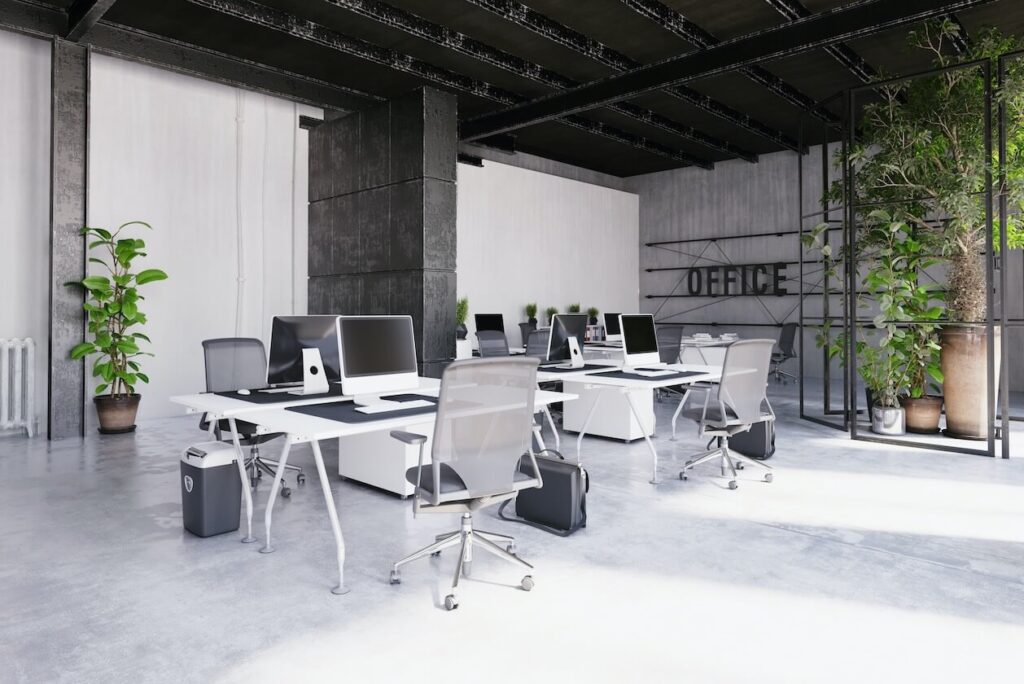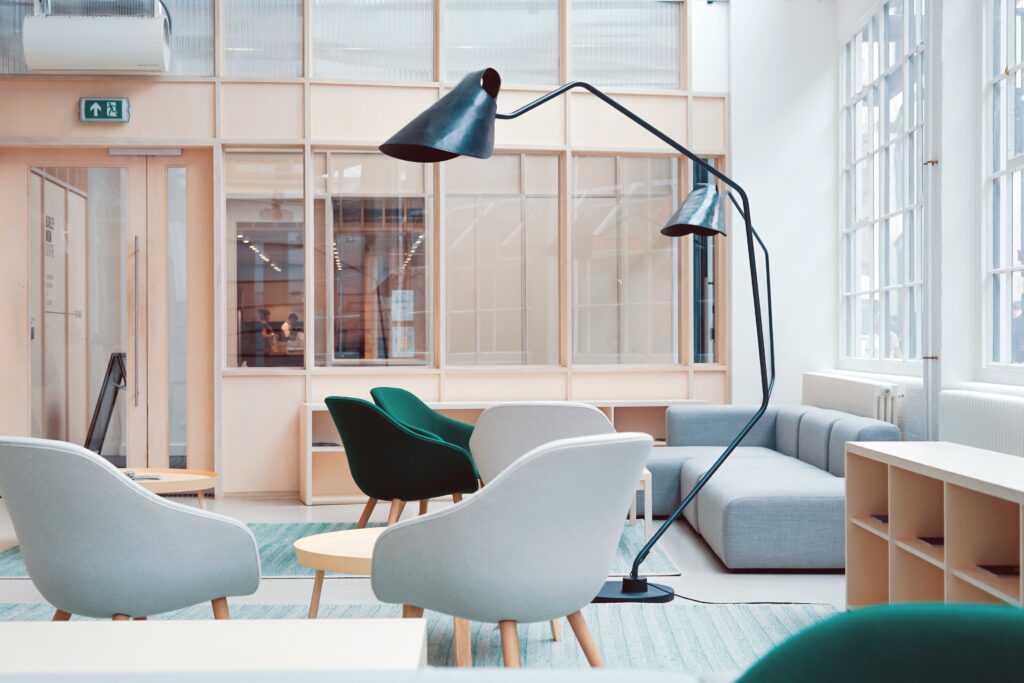Image by Austin Distel on Unsplash
A poorly designed workspace can affect how one feels and performs at work. It can interfere with employees’ comfort, influencing the quality of their work. Office lighting is a prevalent source of discomfort and low productivity in the workplace.
When the lighting is poor, workers have difficulty completing tasks efficiently. Eye strain and headaches are some common ill-health effects associated with bad lighting. Similarly, too much light can cause glare and extreme discomfort, making workers less productive.
A 2022 study revealed that 61.3 percent of workers reported discomfort during computer tasks due to glare from artificial lighting. When asked whether lighting influences their mood, 66.2 percent said it has a significant impact.
Businesses can eliminate these barriers to productivity by providing adequate lighting in the office. Doing so helps create conducive environments where employees can concentrate and thrive in their everyday activities.
Here, we’ll discuss how to incorporate lighting in office designs and strategically use them to fuel creativity and productivity. But first, let’s discuss the importance of lighting in transforming innovative spaces and how to achieve optimal office lighting.
Table of Contents
Lighting as a Key Element in Innovative Office Designs
Working a 9-5 office job can become monotonous, causing employees to be uninspired and lose interest in work.
The lack of innovative features in traditional offices makes it more difficult to kick out that boredom factor. Fortunately, office designs have evolved over the years. Since monotonous workspaces aren’t as effective, creating vibrant and innovative work environments is becoming more necessary.
Innovate office designs help break the monotony in workspaces. But more than enhancing the office’s aesthetic appeal, these designs provide a setting that fosters collaboration and creativity. They also contribute to a better use of workspaces and efficient workflows.
Lighting is essential to transforming uninspiring office spaces into stylish and functional work environments. Yet, it’s one aspect of office design that often gets overlooked. Unsurprisingly, studies show that a mere 35.8 percent of employees are highly satisfied with their workplace lighting.
With that in mind, it’s time for businesses to rethink their office layouts and how crucial lighting is in boosting concentration and efficiency in the workplace. By adopting more impactful lighting strategies, you can create environments that encourage employees to work at their best.
Achieving the Best Office Lighting
Selecting lights for office spaces may seem simple at first. However, it requires careful consideration. It can be tricky to find optimal lighting that helps employees stay alert, creative, and efficient.
Remember, poor and excessive lighting can negatively impact their mood and productivity. The key is to achieve a balance between lighting designs. Below are things to consider when choosing the best lighting for your office:
Standard office lighting
State and federal rules provide standards on how to light up offices properly. Adhering to them is essential to provide a safe, healthy, and productive environment to employees.
The Occupational Safety and Health Administration (OSHA) checks whether businesses follow workplace safety rules, including office lighting standards. Section 1926.56 of the Code of Federal Regulations specifies the minimum illumination requirements in offices and other areas.
Generally, the lighting in a workplace should be spread out evenly to avoid gaps. Doing so helps workers see and move around easily without straining their eyes. It’s worth noting that the right illumination level depends on the nature of the work and whether it involves using computers.
The type of bulb
The bulbs used in your office lighting can also affect the ambiance of the workspace. Different types of bulbs are available, and each one has specific features and uses. Remember, the quality of light they emit and the energy used can change your office’s lighting. Considering that, ensure you select according to the type of work and the time employees perform them.
Light-emitting diode (LED) bulbs are popular because they last longer and save energy. Their versatility also makes them easier to incorporate into office designs.
Fluorescent bulbs are another common option, especially in large spaces. Since they produce a variety of white light, they can accommodate various lighting needs.
Brightness balance
Brightness balance is how light spreads around a room and impacts one’s ability to see comfortably.
A place that’s either overly bright or too dim can strain the eyes. It can also cause employees to feel worn out or experience mood problems. Hence, it’s crucial to balance the office’s space brightness to ensure that it provides the visual comfort workers need to perform their tasks.
OSHA provides guidelines on appropriately positioning lighting and choosing the correct brightness level in computer workstations. Complying with these lighting requirements keeps workers safe from accidents. It also ensures they’re working in comfortable conditions with minimal strain.
Color appearance and temperature
Considering the color and temperature of your office lighting design is also vital in creating a comfortable environment for your employees. They can have different physiological effects on individuals.
Generally, warm lights help people feel more relaxed and comfortable. Restaurants often use these lights because of their cozy effects. They encourage customers to stay longer and eat more. They can also work well in an office break room.
Meanwhile, exposure to cool blue or white lights can help boost alertness and attentiveness. This awakening effect can minimize daytime sleepiness, enabling employees to concentrate and remain productive.
Lighting fixtures combinations
How the light fixtures look is also essential. When deciding on your office lighting, you must ensure that they’re aesthetically pleasing and match the vibe of the office space. You can combine lighting fixtures to create visually appealing and expertly lit workspaces.
Ensure that your office lighting feels natural and unobtrusive. Designer pendant lights, in particular, are an excellent option for your workspaces. They are stylish and customizable. You can seamlessly blend them into your office designs.
Computer placement
Another variable to consider in your office lighting is the computer placement. Computers and laptop screens can cause glare and eye strain when positioned incorrectly. The lights’ brightness and the office windows’ location can be so intense that it is hard for employees to work.
Arrange your office lights and computers accordingly. You can lessen the glare by putting the computer screen sideways to the windows. It’s also wise to position the screen away from bright lights and use matte screens to reduce reflections.
Creative Lighting Design Ideas To Transform Office Spaces
Image by Product School on Pexels
Different types of workspaces require the right kind of illumination. Now that you know what comprises the best office lighting, you can better transform your space with strategic lighting choices.
There are many ways to illuminate office spaces, but consider these lighting design ideas to get started:
Take advantage of natural light
Exposure to natural light can help improve employees’ moods, allowing them to work better. The glow natural lighting produces is softer than artificial light. Since they reduce the pressure on the eyes, workers can focus better on tasks with minimal eye strain and headaches.
Make your office more productive by taking advantage of natural light. For instance, open up the shades or position workstations near windows. You can also use glass partitions to allow the light to reach further into the office space.
Suppose the office has few windows, and natural lighting isn’t possible. Consider putting office lights that look and feel like natural light in workspaces.
Employ ergonomic lighting fixtures
Ergonomic office lighting combines both standalone and adjustable lighting. Install lights with adjustable options to let employees customize their workspace to their preferences and needs. Some prefer brighter light for specific tasks, while others need softer lighting for reading or computer work.
For instance, lights with movable arms or heads allow employees to direct the light where needed. Likewise, desk lamps with adjustable brightness settings can help minimize eye strain, making it easier for employees to see what they’re doing.
Create lighting zones
Dividing the office into different lighting areas can help create a balanced and functional workspace. For instance, you can install brighter lights in spaces designated for open work. A slightly dimmer lighting design can work well in meeting rooms. It helps create an atmosphere for collaboration.
The key is to designate areas for specific office functions and provide them with the appropriate lighting scheme. This way, you can accommodate the lighting needs of various tasks and moods in the office.
Invest in energy-efficient lighting
Investing in energy-efficient lighting is also a good idea to reduce the costs associated with your office lighting system.
Consider switching to LED or fluorescent lights since they consume less energy. They also work for longer periods than traditional light bulbs. You can also install sensors or timers to control the lights.
Boost Creativity and Productivity With Well-Lit Workspaces
The design and layout of office spaces must inspire innovation. It should empower employees to become more creative and productive.
Well-lit workspaces help employees perform their jobs comfortably. This visual comfort promotes focus and productivity. Organizations should invest in good and strategic office lighting so their workforce can excel and contribute to overall success.
The post Innovative Office Designs: Lighting Up Creativity appeared first on Entrepreneurship Life.





Leave a Reply